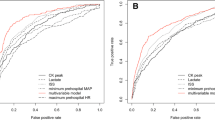Abstract
Background/Objective
Traumatic brain injury (TBI) is a leading cause of morbidity, mortality, and disability in the USA. While cardiopulmonary dysfunction can result in poor outcomes following severe TBI, the impact of acute kidney injury (AKI) is poorly understood. We examined the association of severe AKI with hospital mortality and healthcare utilization following isolate severe TBI.
Methods
We conducted a retrospective cohort study using the National Trauma Data Bank from 2007 to 2014. We identified a cohort of adult patients with isolated severe TBI and described the incidence of severe AKI, corresponding to Acute Kidney Injury Network stage 3 disease or greater. We examined the association of severe AKI with the primary outcome of hospital mortality using multivariable logistic regression models. In secondary analyses, we examined the association of severe AKI with dialysis catheter placement, tracheostomy and gastrostomy utilization, and hospital length of stay.
Results
There were 37,851 patients who experienced isolated severe TBI during the study period. Among these patients, 787 (2.1%) experienced severe (Stage 3 or greater) AKI. In multivariable models, the development of severe AKI in the hospital was associated with in-hospital mortality (OR 2.03, 95% CI 1.64–2.52), need for tracheostomy (OR 2.10, 95% CI 1.52–2.89), PEG tube placement (OR 1.88, 95% CI 1.45–2.45), and increased hospital length of stay (p < 0.001).
Conclusions
The overall incidence of severe AKI is relatively low (2.1%), but is associated with increased mortality and multiple markers of increased healthcare utilization following severe TBI.

Similar content being viewed by others
References
Rutland-Brown W, Langlois JA, Thomas KE, ** YL. Incidence of traumatic brain injury in the United States, 2003. J Head Trauma Rehabil. 2006;21:544–8.
Saatman KE, Duhaime AC, Bullock R, et al. Classification of traumatic brain injury for targeted therapies. J Neurotrauma. 2008;25:719–38.
Mascia L, Sakr Y, Pasero D, Payen D, Reinhart K, Vincent JL. Extracranial complications in patients with acute brain injury: a post hoc analysis of the SOAP study. Intensive Care Med. 2008;34:720–7.
Jeremitsky E, Omert L, Dunham CM, Protetch J, Rodriguez A. Harbingers of poor outcome the day after severe brain injury: hypothermia, hypoxia, and hypoperfusion. J Trauma. 2003;54:312–9.
Manley G, Knudson MM, Morabito D, Damron S, Erickson V, Pitts L. Hypotension, hypoxia, and head injury: frequency, duration, and consequences. Arch Surg. 2001;136:1118–23.
Krishnamoorthy V, Rowhani-Rahbar A, Gibbons EF, et al. Early systolic dysfunction following traumatic brain injury: a cohort study. Crit Care Med. 2017;45:1028–36.
Moore EM, Bellomo R, Nichol A, Harley N, Macisaac C, Cooper DJ. The incidence of acute kidney injury in patients with traumatic brain injury. Ren Fail. 2010;32:1060–5.
Maegele M. Coagulopathy after traumatic brain injury: incidence, pathogenesis, and treatment options. Transfusion. 2013;53(Suppl 1):28S–37S.
Corral L, Javierre CF, Ventura JL, Marcos P, Herrero JI, Manez R. Impact of non-neurological complications in severe traumatic brain injury outcome. Crit Care. 2012;16:R44.
Lee S, Hwang H, Yamal JM, et al. IMPACT probability of poor outcome and plasma cytokine concentrations are associated with multiple organ dysfunction syndrome following traumatic brain injury. J Neurosurg. 2019;131:1931–7.
Lin CY, Chen YC. Acute kidney injury classification: AKIN and RIFLE criteria in critical patients. World J Crit Care Med. 2012;1:40–5.
Haider AH, Hashmi ZG, Zafar SN, et al. Develo** best practices to study trauma outcomes in large databases: an evidence-based approach to determine the best mortality risk adjustment model. J Trauma Acute Care Surg. 2014;76:1061–9.
Rosner MJ, Newsome HH, Becker DP. Mechanical brain injury: the sympathoadrenal response. J Neurosurg. 1984;61:76–86.
Koiv L, Merisalu E, Zilmer K, Tomberg T, Kaasik AE. Changes of sympatho-adrenal and hypothalamo-pituitary-adrenocortical system in patients with head injury. Acta Neurol Scand. 1997;96:52–8.
Rizoli SB, Jaja BN, Di Battista AP, et al. Catecholamines as outcome markers in isolated traumatic brain injury: the COMA-TBI study. Crit Care. 2017;21:37.
McDonald SJ, Sharkey JM, Sun M, et al. Beyond the brain: peripheral interactions after traumatic brain injury. J Neurotrauma. 2020;37:770–81.
Wiersema R, Eck RJ, Haapio M, et al. Burden of acute kidney injury and 90-day mortality in critically ill patients. BMC Nephrol. 2019;21:1.
Ramtinfar S, Chabok SY, Chari AJ, Reihanian Z, Leili EK, Alizadeh A. Early detection of nonneurologic organ failure in patients with severe traumatic brain injury: multiple organ dysfunction score or sequential organ failure assessment? Indian J Crit Care Med. 2016;20:575–80.
Erdman MJ, Riha H, Bode L, Chang JJ, Jones GM. Predictors of Acute kidney injury in neurocritical care patients receiving continuous hypertonic saline. Neurohospitalist. 2017;7:9–14.
Wilcox CS. Regulation of renal blood flow by plasma chloride. J Clin Invest. 1983;71:726–35.
Maguigan KL, Dennis BM, Hamblin SE, Guillamondegui OD. Method of hypertonic saline administration: effects on osmolality in traumatic brain injury patients. J Clin Neurosci. 2017;39:147–50.
Zeng J, Tong W, Zheng P. Decreased risk of acute kidney injury with intracranial pressure monitoring in patients with moderate or severe brain injury. J Neurosurg. 2013;119:1228–32.
Skrifvars MB, Moore E, Martensson J, et al. Erythropoietin in traumatic brain injury associated acute kidney injury: a randomized controlled trial. Acta Anaesthesiol Scand. 2019;63:200–7.
Funding
Dr. Krishnamoorthy received funding from the National Institutes of Health (K23 NS109274).
Author information
Authors and Affiliations
Contributions
All authors contributed to the conception and design of the work, analysis, interpretation, drafting the manuscript and have given final approval of the published work.
Corresponding author
Ethics declarations
Conflict of interest
Authors declare no conflict of interest.
Ethical Approval/Informed Consent
The NTDB is fully de-identified and, therefore, exempt from Institutional Review Board (IRB) review and informed consent by the Duke University Health System IRB.
Additional information
Publisher's Note
Springer Nature remains neutral with regard to jurisdictional claims in published maps and institutional affiliations.
Electronic Supplementary Material
Below is the link to the electronic supplementary material.
Rights and permissions
About this article
Cite this article
Luu, D., Komisarow, J., Mills, B.M. et al. Association of Severe Acute Kidney Injury with Mortality and Healthcare Utilization Following Isolated Traumatic Brain Injury. Neurocrit Care 35, 434–440 (2021). https://doi.org/10.1007/s12028-020-01183-z
Received:
Accepted:
Published:
Issue Date:
DOI: https://doi.org/10.1007/s12028-020-01183-z




